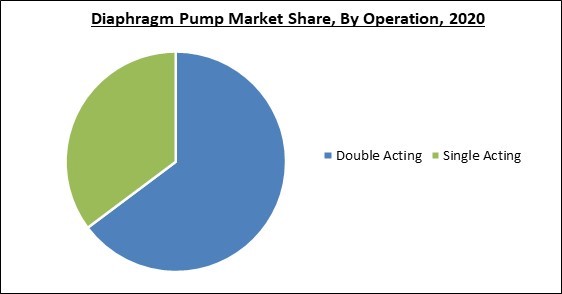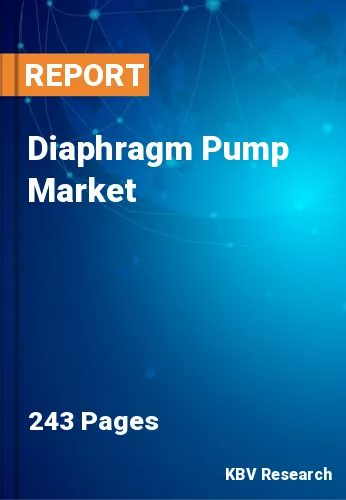The Global Diaphragm Pump Market size is expected to reach $7.3 billion by 2027, rising at a market growth of 5.2% CAGR during the forecast period.
A diaphragm pump, commonly referred to as a membrane pump, is a highly well-known type of positive displacement pump. In addition, in fluid pumping, a diaphragm pump combines the reciprocating action of a thermoplastic, Teflon, or rubber diaphragm with equivalent valves (flap valves, globe valves, check valves, butterfly valves, or any other type of valve) on both sides of the diaphragm.
Diaphragm pumps are commonly employed in a variety of factories because they can handle a wide range of fluids. Moreover, diaphragm pumps are known for their high viscous moveable property, which allows them to move liquids with high, medium, or low viscosity as well as liquids with high solid content. To handle a variety of severe chemicals, such as acids, this pump can be built from various body materials and membranes.
Pharmaceutical, oil and gas, food and beverage, and other industries rely heavily on diaphragm pumps. Additionally, some of the growth catalysts for the overall diaphragm pump market are increased global demand for medications, petroleum, and other food products and growing demand for diaphragm pumps in government projects.
A diaphragm pump is a positive displacement pump that employs a combination of reciprocating action and either a flapper valve or a ball valve to transfer liquids. It can be hydraulically or mechanically activated. In addition, Self-priming diaphragm pumps are good for thick liquids. Moreover, Diaphragm pumps are employed in almost every major industry and are typically used to transfer abrasive fluids such as concrete, acids, and chemicals. They're also widespread in cars and airplanes.

The COVID-19 pandemic has slowed the global movement of people, commodities, and services in most of the countries where the manufacturing of diaphragm pumps is widespread. A number of local, state, and national governments have imposed various restrictions on the conduct of business and travel, such as stay-at-home orders and quarantines, as part of their increased efforts to contain the spread of COVID-19, resulting in a significant number of business slowdowns and closures.
The COVID-19 pandemic has resulted in a significant reduction in business activities (including a drop in demand for a wide range of goods and services), weakened economic conditions, supply chain disruptions, significant economic uncertainty, and volatility in the financial and commodity markets, including a drop in global demand for oil and gas combined with excess supply due to OPEC disagreements. Moreover, the disruption of all of the aforementioned activities resulted in a fall in diaphragm pump demand, which had an adverse impact on the overall market during the pandemic period.
As the global demand for water grows, the amount of wastewater produced and the pollution load on the environment grows as well. As a result, governments all over the world have enacted severe policies and regulations for both urban and industrial wastewater treatment. Approximately two-thirds of the world's population lives in locations where water scarcity occurs at least once a year. Around half of the people who are affected by water, scarcity lives in India and China. As a result, demand for wastewater treatment, which is generated as a result of human and industrial sector water usage, is predicted to rise in order to increase water efficiency and meet water demands.
Many tiny diaphragm pumps have been developed as a result of technological breakthroughs, and their designs are quite simple. Moreover, diaphragm pumps include qualities such as variable flow control, minimal maintenance costs, and little downtime that make them excellent for a wide range of applications. Diaphragm pumps are well suited to carry poisonous and corrosive fluids without leakage in various offshore drilling applications. In addition, the development of air-operated double diaphragm pumps for the movement of liquids containing big solids without the use of electricity.
The presence of various types of pumps that serve the same purpose, such as submersible water pumps, agitation pumps, progressive capacity pumps, and other high-pressure pumps would pose a serious threat to the industry players. Moreover, these pumps are being used intensively around the world. In addition, there have been technical improvements in alternative solutions for traditional pumps, such as solar pumps in the last few years. Further, Water hammering is a problem that can occur with air-operated double diaphragm pumps. Furthermore, pulsation is linked to diaphragm pumps, creating vibration and so limiting their use in certain applications. Also, many local people are offering alternative products at a lower cost along with better marketing strategies.

Based on Mechanism, the market is segmented into Air Operated and Electrical Operated. In 2020, the Air Operated segment acquired the highest revenue share of the Diaphragm Pump Market. This is because the air-operated pumps have a wide range of applications in the chemical, pharmaceutical, and oil & gas industries. Moreover, Compressed air is used to power air-operated diaphragm pumps, allowing them to move a wide range of fluids, including slurries, sludge, abrasive, and high viscosity fluids.
Based on Discharge Pressure, the market is segmented into Up to 80 bars, 80 to 200 bars, and Above 200 bars. In 2020, the Up to 80 bars segment procured the largest revenue share of the Diaphragm Pump Market. This is due to an increase in infrastructural development, which has resulted in a higher demand for paints and coatings. Moreover, the growth of the segment would be driven because of the high demand from the oil and gas industry, as well as an unexpected increase in demand. Moreover, this type of diaphragm pump is preferred by practically all end-user industries.
Based on Operation, the market is segmented into Double Acting and Single Acting. The Single-acting segment held a significant revenue share of the Diaphragm Pump Market in 2020. This type of pump is appropriate for pumping any liquid that can travel through a pipe or hose. In the low flow range, the single-acting pump can handle everything from water to sludge and offers versatility in a wide range of applications. The pump is ideal for situations requiring portable and submersible equipment. It is possible to operate it dry without causing harm to the pump or valves.
Based on End User, the market is segmented into Water & Wastewater, Oil & Gas, Chemicals & Petrochemicals, Pharmaceuticals, Food & Beverage, and Others. The Oil & Gas segment obtained a significant revenue share of the Diaphragm Pump Market in 2020. This is because aluminium diaphragm pumps are widely used in the oil and gas industry for pumping petroleum products, chemicals, natural gas liquids (NGLs), water emulsion, and other liquids. Depending on the use, aluminium diaphragm pumps can be installed in both onshore and offshore facilities.
| Report Attribute | Details |
|---|---|
| Market size value in 2020 | USD 5.3 Billion |
| Market size forecast in 2027 | USD 7.3 Billion |
| Base Year | 2020 |
| Historical Period | 2017 to 2019 |
| Forecast Period | 2021 to 2027 |
| Revenue Growth Rate | CAGR of 5.2% from 2021 to 2027 |
| Number of Pages | 243 |
| Number of Tables | 450 |
| Report coverage | Market Trends, Revenue Estimation and Forecast, Segmentation Analysis, Regional and Country Breakdown, Companies Strategic Developments, Company Profiling |
| Segments covered | Mechanism, Discharge Pressure, Operation, End User, Region |
| Country scope | US, Canada, Mexico, Germany, UK, France, Russia, Spain, Italy, China, Japan, India, South Korea, Singapore, Malaysia, Brazil, Argentina, UAE, Saudi Arabia, South Africa, Nigeria |
| Growth Drivers |
|
| Restraints |
|
Based on Regions, the market is segmented into North America, Europe, Asia Pacific, and Latin America, Middle East & Africa. In 2020, the Asia-Pacific region emerged as the leading region in the overall Diaphragm Pump Market. This can be linked to the growth of the pharmaceutical and chemical industries in this region. In terms of industrial infrastructure development, Asia-Pacific is experiencing tremendous economic growth. The rise in population is primarily responsible for the increase in industrial output.
Free Valuable Insights: Global Diaphragm Pump Market size to reach USD 7.3 Billion by 2027
The market research report covers the analysis of key stake holders of the market. Key companies profiled in the report include GemmeCotti srl, Graco Inc. (Newell Brands Inc.), Grundfos Holding A/S, Tapflo Group, LEWA GmbH, Xylem, Inc., Dover Corporation, Flowserve Corporation, IDEX Corporation (Phantom Controls, Inc.), and Ingersoll Rand Inc.
By Mechanism
By Discharge Pressure
By Operation
By End User
By Geography
The global diaphragm pump market size is expected to reach $7.3 billion by 2027.
A growing number of technological developments are driving the market in coming years, however, availability of alternative products limited the growth of the market.
GemmeCotti srl, Graco Inc. (Newell Brands Inc.), Grundfos Holding A/S, Tapflo Group, LEWA GmbH, Xylem, Inc., Dover Corporation, Flowserve Corporation, IDEX Corporation (Phantom Controls, Inc.), and Ingersoll Rand Inc.
The Double Acting segment has acquired maximum revenue share in the Global Diaphragm Pump Market by Operation 2020, thereby, achieving a market value of $4.6 billion by 2027.
The Asia Pacific is the fastest growing region in the Global Diaphragm Pump Market by Region in 2020, and would achieve a market value of $2.6 billion by 2027.
Our team of dedicated experts can provide you with attractive expansion opportunities for your business.

